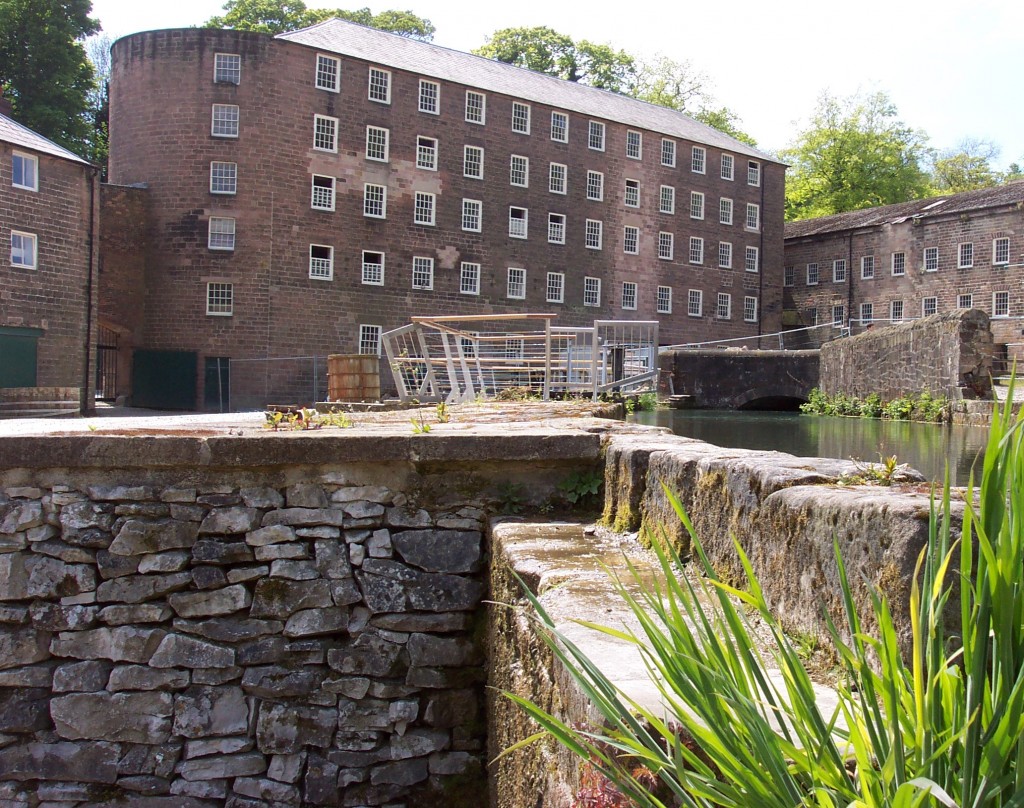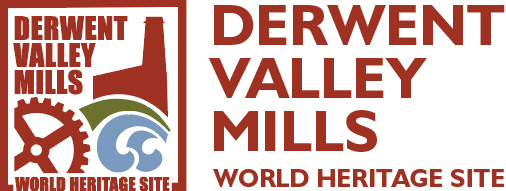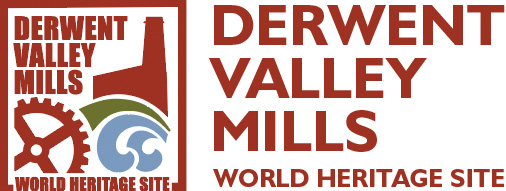Key Sites – Cromford Mill

Key Sites – Cromford Mill
It was at Cromford that Richard Arkwright extended the range and scale of his mechanisation of cotton spinning and devised the factory production techniques which yoked machinery, the workforce and water power as they had never been harnessed before. In his hands the factory system evolved and matured, creating a model which was recognised and copied across the world.
First Steps
Richard Arkwright’s first steps in Cromford were slow and tentative. It is clear from a letter of March 1772, seven months after the lease at Cromford had been signed, that though he boasted to his partner Jedediah Strutt that he would be able to make “three frames in a fortnet” [sic] in reality, not a single frame had been made. Nor had the building been completed: the sash windows were still to be fitted and he was waiting for latches and door fittings. He was also still recruiting key staff and not finding it easy.
Apart from this glimpse of early difficulties, little is known of the first years of the new enterprise. To power the mill Richard Arkwright separated Cromford Sough from the Bonsall Brook and created a new watercourse to the mill probably taking it across the road by aqueduct. It is known from the details of a dispute with his landlord that the mill was operational by 1774 but no further information is available. Much of his time in the early years in Cromford must have been taken up with experiment. Between 1772 and 1775 he perfected the mechanisation of the pre-spinning processes, the key elements of which were embodied in his second patent of 1775 and which he put into operation in his second Cromford Mill built in 1776-77.
To finance this venture Arkwright looked outside the partnership which had built the first mill and turned to Peter Nightingale, a wealthy lead merchant and neighbouring land owner. At a cost of £20,000, Nightingale took over the purchase of the Cromford Estate which Arkwright had negotiated and, perhaps as a reward to Arkwright, committed himself to building Arkwright a residence. The site they chose overlooked the mill. Rock House became Arkwright’s home for the rest of his life. In a subsequent arrangement Nightingale provided Arkwright with £2,000 for the second Cromford Mill and a further £1,000 to build houses for the work people.
The housing Nightingale financed was in North Street and in 1780 a further £750 was paid for houses higher up Cromford Hill. There may well have been other financial arrangements to support buildings at the mill site or in the village as, for example, the construction of the “Black Greyhound” or “Black Dog” as the Greyhound Inn was first known; but no details have survived.
The Arkwright Business Empire is Born
The development of the second Cromford Mill in 1776-77 was followed by a period of intense activity. In 1777 mills were built by Arkwright and his family at Birkacre, Bakewell and Wirksworth; at Rocester in 1781 and at Cressbrook in 1783. Between 1776 and 1781 his partner in the first Cromford Mill, Jedediah Strutt, built his first mills at Belper and at Milford. Elsewhere, royalty agreements licensing the use of Arkwright machinery allowed the Arkwright system to proliferate in addition to which there were those who pirated his machinery and operated outside the law. Notwithstanding substantial expansion further afield, Arkwright continued to develop his mill enterprise at Cromford. There is more than a hint of major growth in 1781 when the mills advertised for:
“FORGING and Filing Smiths, Joiners and Carpenters, Framework-Knitters and Weavers, with large Families. Likewise Children of all Ages; above seven Years old, may have constant Employment. Boys and young Men may have Trades taught them, which will enable them to maintain a Family in a short Time. Two or three young Men who can write a good Hand, are also wanted.
By personal Application at the COTTON-MILLS, Particulars may be known.
SEPTEMBER 19, 1781″
It has not yet proved possible to link this expansion to a particular building phase at Cromford.
In 1783 he turned his attention to Matlock Bath and to the construction of Masson Mill. This was built on land acquired in 1780 from the proprietors of the adjacent paper mill which had been erected in 1769. It is not known when Masson was first in production but it is likely to have been in time for the boom years of 1786-87.
The Mills after Richard Arkwright
After Sir Richard Arkwright’s death in 1792, Richard Arkwright junior sold most of his remaining cotton mill interests outside Matlock Bath and Cromford. That he retained these mills may well have had more to do with their role in sustaining the Willersley Estate than their inherent profitability.
At Cromford the disputes over water rights which had rumbled on through the 1830s reached a conclusion in 1839 and, by 1847, when Thomas Carlyle visited the area, he was made aware the end was near. He wrote to his brother “the Mother of all the Mills [is] very nearly fallen silent now, likely soon to go out altogether”.
From the late 1820s profits from the Cromford and Masson Mills are likely to have been nominal and there are few indications of any attempt to improve their performance. In 1834 the Factories Inquiry recorded that water frames were still in use in the Arkwright Mill and 20 years later when the son of Johann Gottfried Brugelmann visited Masson he was amazed to see “the great inventor’s machinery, mahoganied by age, is still at work…. after more than seventy years of toil”. The mills passed to Peter Arkwright 1784-1866 and on in turn to Frederic Arkwright 1806-74. The family earned universal acclaim locally for keeping the mills at work during the cotton famine in the early 1860s at considerable cost to themselves, but their patience was not infinite. In 1872 Frederic had both sites valued and came close to a sale. Only Masson had retained any value. No more than a small section of the Cromford Mill remained in use: a winding room; a blowing room; and a making up room. But it was left to his son, Frederic Charles Arkwright (1853-1923) to resolve the problem. In 1883 he brought into partnership an experienced cotton spinner from Dukinfield, John Edward Lawton and it was Lawton who breathed new life into Masson Mill.
Renaissance
With new machinery, new working practices and new supervisors imported from Lancashire, Masson entered the growing market for sewing thread created by the popularity of sewing machines. A measure of Lawton’s success is the substantial mansion he built, Cromford Court, overlooking Masson Mill. By 1890, Masson Mill was exporting its products to Melbourne, Calcutta, Madras, Constantinople, France, Spain, Mexico, Vera Cruz, Mauritius, the Canary Islands, British Columbia, Chile, Monte Video, Buenos Aires and the West Indies. In 1897, the mill became part of the English Sewing Cotton Company. It continued in use until 1992. Work then began to adapt it to new uses and, after a major repair programme had been completed, it opened in its new form in 1999.
Cromford Mill: the Colour Works Years
The Cromford Mill site was less fortunate. It had no place in Lawton’s plan. Towards the end of the 19th century, sections of it were used as a brewery and one of the buildings became a laundry. The Arkwright machinery at Cromford Mill was advertised for sale but there was little interest. Platts, the great textile machinery makers, acquired a water frame and other pieces to use as exhibition items to help them sell their modern equipment. Ultimately their purchases found their way to the Helmshore museum in Lancashire where they are still to be seen. Other items were donated by the Arkwright family to the Science Museum in London. Most of the Cromford machinery is thought to have been smashed. The second mill remained in a useable state and was let to William Hollins, the inventor of Viyella, a name derived from the nearby Via Gellia, whose company was using it in 1890 when it was destroyed by fire.
Early in the 20th century, the Arkwright family sold Cromford Mills and the site was divided between a colour pigment manufacturer and a laundry. It was intensively developed, every open space pressed into service for production units. The water courses were covered over and built upon and the historic buildings disfigured by lift shafts, lean-to sheds and new doorways and window openings.
In 1929 fire destroyed two floors of the first mill (Building 18), and in 1961 fire reduced the bow fronted building (the Barracks) to a shell which was subsequently demolished.
Rescue and Conservation
By 1979, it was no longer economic to manufacture colour pigments at Cromford Mill. It was purchased by the Arkwright Society, the local civic society for the Matlock area. The Society embarked on an incremental strategy of repair and re-use.
Cromford Mill is now home to a range of small businesses and retail outlets which provide work for approximately 100 people. At the same time, the mills operate as a popular heritage destination welcoming visitors from all over the world.
Cromford Mill – First Steps (pdf)

